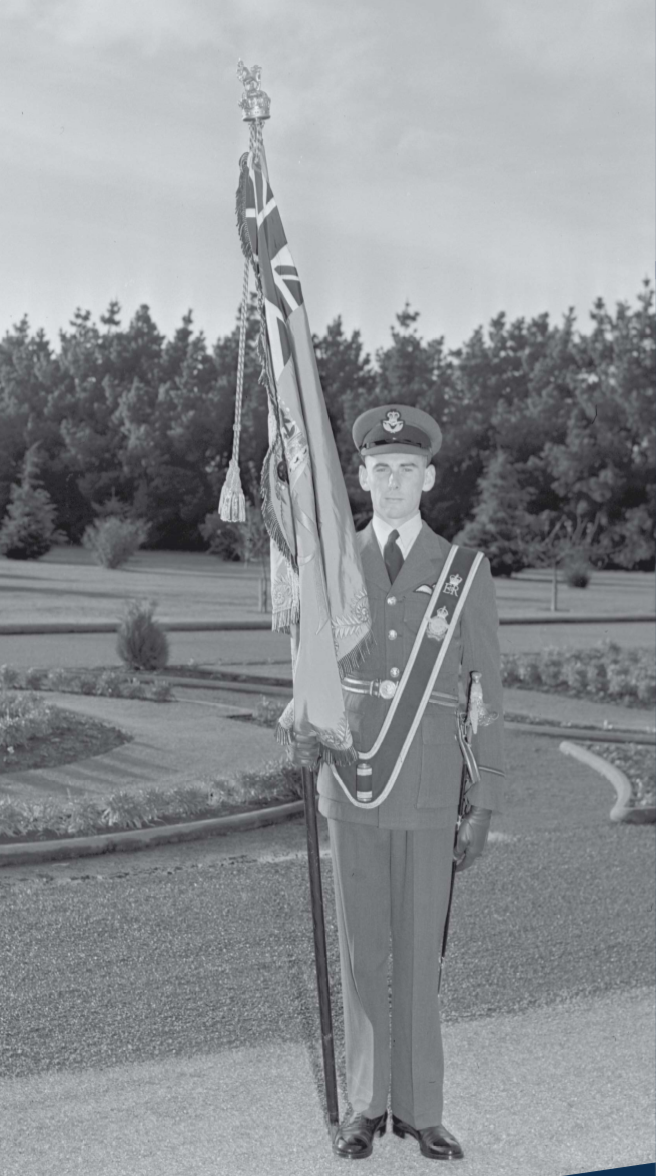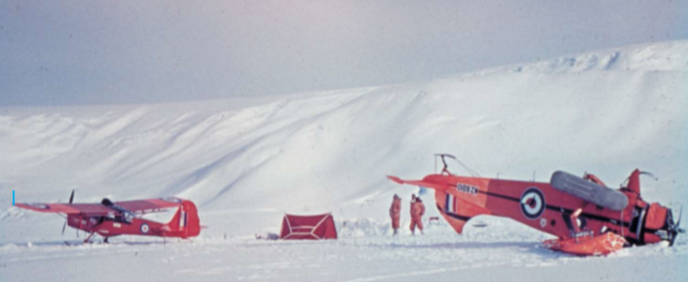The story of Squadron Leader Peter Rule
The below was taken from the New Zealand Defence Force, prepared as part of their celebration of 25 years of LGBT+ men and women being able to serve openly.
A passion for flying
Official portrait of Squadron Leader Peter Rule - May 1972. RNZAF Official. Port-Rule-PS5
Squadron Leader Peter Rule had a distinguished career in the RNZAF, was a member of the RNZAF Antarctic Flight, represented New Zealand as a Military Liaison Officer at the United Nations, serving in Korea and the Middle East, and was awarded an MBE for his work.
Yet in the mid-1970s he was pressured to leave the Air Force because he was gay. Peter was devastated. He went on to make a successful career as an arts administrator but he suffered from depression and in 1987 he committed suicide.
From today’s perspective, this was a tragedy that should never have happened. The Homosexual Law Reform Act was passed in 1986 but it was the reform of the Human Rights Act in 1994 prohibiting discrimination on the grounds of sexual orientation that brought significant change. Since then, LGBT+ men and women have been welcome to serve openly in the New Zealand Defence Force (NZDF).
25 years on, NZDF personnel, from the most senior ranks down, make a point of taking part in Pride Parades around the country, celebrating diversity. With this exhibition honouring Peter Rule’s life, the NZDF also wants to acknowledge those who in the past suffered discrimination on the grounds of their sexual orientation.
A stand-out career
Flight Lieutenant Rule as Queen’s Colour bearer at RNZAF Station Wigram - June 1957. RNZAF Official. WgG7178-57
Born in Auckland in 1931, Peter Rule grew up and went to school in Gisborne before going on to Auckland University College. In his early 20s he travelled to England via a Rover Scout event in Switzerland. From England he and his friend Ken Bloomfield took off on a two–month flying adventure to return home. Older than Peter, Ken was the pilot.
It wasn’t the first time Peter had been around aircraft – before going to England, he had worked for a top dressing company as a loader driver. Back in New Zealand he did his compulsory military training with the Air Force and with that obligation completed, in 1954 he enlisted in the RNZAF as a cadet pilot.
1959 gave him the opportunity of another great adventure – he was selected as one of five pilots for the RNZAF Antarctic Flight which was formed to support the 1955–58 Commonwealth Trans-Antarctic Expedition operating out of Scott Base.
Peter was then seconded to the United Nations on three tours of duty, and rose to the rank of Squadron Leader.
In 1972 Peter was awarded the MBE “For distinguished services to the RNZAF and the Ministry of Defence, particularly during two tours of duty as NZ Military Representative, United Nations Command, South Korea.”
Preparation for Antarctica
In 1959, Peter was selected as one of five pilots for the RNZAF Antarctic Flight. In preparation for working on the Ice, the team were sent to Mt Cook National Park. Initially based at the Ball Hut, they were introduced to serious alpine mountain climbing by renowned New Zealand mountaineer Harry Ayres.
Before going to Antarctica, members of the RNZAF Antarctic Flight carried out survival training in the Mt Cook area to gain experience in extreme cold weather environments - August 1959. RNZAF Official. PR1980-1-59
The RNZAF Antarctic Flight Beaver at Mt Cook airield during alpine lying and survival exercises - August 1959. (RNZAF Official. PR1975-6-59)
They also practised ski-plane take-offs and landings on and off the Tasman Glacier lying the RNZAF Antarctic Flight Beaver aircraft and the Auster owned by equally renowned New Zealand aviator Harry Wigley, who was their instructor. They would fly the RNZAF’s Antarctic Auster down on the Ice.
Fellow pilot Peter Tremayne wrote in his account of the RNZAF Antarctic Flight that “Pete was an excellent pilot, an excellent light instructor and a wonderful person to be around.”
Survival on the Ice
The crashed Beaver aircraft, after Bill Cranfield of the RNZAF Antarctic Flight had arrived in the Auster (left) to rescue them. Air Force Museum of New Zealand. MUS0900837
Down in Antarctica, there was a supplies depot on the Beardmore Glacier. One of the tasks of the Antarctic Flight team was to fly ration boxes up there from Scott Base for the next year’s operations. However, at 1500 hrs on 15 January 1960, Peter and Squadron Leader Les Jeffs crashed in the Beaver in whiteout conditions on an unknown glacier about 400 miles away from Scott Base.
Neither of them was seriously hurt and they managed to salvage the survival kit in the aircraft. They dug a deep trench in which to put up their tent and with the emergency transmitter they sent out SOS signals.
Peter Rule (left) and Les Jeffs standing by the crashed Beaver in the Beardmore Glacier area. January 1960. Air Force Museum of New Zealand. MUS19093
The Auster, piloted by Flight Lieutenant Bill Cranield, flew to rescue them but the weather closed in and all three men ended up at the crash site for several days. They did make it out to the Beardmore Glacier but were there for another few days before being rescued by American colleagues.
Disappointingly, the accident brought the RNZAF Antarctic Flight to an end. Peter and fellow pilot Peter Tremayne were then assigned as instructors to the Ground Squadron of the Flying Training School at Wigram.
Distinguished service
Escorting the United States Secretary of Defense, Neil McElroy, on an inspection of an RNZAF guard of honour at Harewood. 13 October 1959.
1966 brought a new direction for Peter. He was seconded for 11 months as a Military Liaison Officer with the United Nations Military Armistice Commission at Panmumjon, South Korea. He returned to Korea for a second tour in 1968. Now a Squadron Leader, he remained there until 1971. He was widely accepted as a diplomatic representative, carrying out many of the functions that would later be taken on by the New Zealand Embassy in Seoul.
On his return to New Zealand, Peter was the Military Assistant and Aide-de-Camp to the Chief of Defence. In 1972, he was awarded the MBE in recognition of his services in Korea. That same year, he took up a new, two year United Nations post as an Observer with the UN Truce Supervisor Organisation in Syria and Israel.
Peter’s diplomatic skills had been recognised and there was some suggestion that he might be seconded to the Ministry of Foreign Affairs. He came home from the Middle East keenly hoping that would happen.
In fact, word had got to the senior hierarchy that Peter was gay, and it was made plain to him that there would be no chance of further promotion. In the coded language of the day, he was being told to quietly leave the Air Force. He was devastated. With cruel irony, at the same time he received notification from the Ministry of Defence that he had been awarded a UN medal for his services in the Middle East.
Forging a new career
‘Kahurangi Kiwi’, the pounamu carving by Hepi Maxwell, was one of the works in Kahurangi – Treasures of New Zealand at the 1984 Los Angeles Olympics. Te Papa (B.070915)
Peter had a great interest in crafts. He was something of a perfectionist and always well-organised and his friends in the arts community – notable among them ceramicist and art educator Doreen Blumhardt – encouraged him into arts administration. At this time Peter hadn’t come out to his family, and they assumed that his UN tour had come to an end and he was simply looking for a new direction.
From 1977 to 1987, he was Director of the Central Regional Arts Council in Wellington and actively promoted pottery, weaving, and carving. He was an early supporter of the renaissance of Māori arts through the 1970s, and a career highlight for him was his coordination of Kahurangi: Treasures of New Zealand, the exhibition curated by Doreen Blumhardt. It was the first major exhibition of New Zealand contemporary craft to be held in the United States and was displayed in Los Angeles during the 1984 Olympic Games.
Jenny Pattrick was Chair of the Craft Council and a member of the Arts Council at the time. “Peter was a good friend. Special. And he did some really good work with the Arts Council.”
Kahurangi was widely admired and the Central Regional Arts Council was increasingly successful, but friends say Peter began to show signs of severe depression. Family believe he was not well treated by the Arts Council at this time, and he left in mid-1987.
Peter sitting in the back garden of his home in Cecil Rd, Wadestown, Wellington. The photograph was taken by renowned photographer Brian Brake, who was a close friend.
Isolation and loneliness
Peter committed suicide in late 1987, aged 56.
There was a family history of depression and it is possible that the crash in Antarctica contributed to the migraines he later suffered. Peter, already undermined by being forced to leave the Air Force, increasingly appeared to lose confidence in himself. With hindsight, his family realised that with characteristic thoughtfulness Peter had spent his last months putting his affairs in order.
Writing to his trustees he speaks poignantly of the difficulties he had suffered as a gay man in an era of non-acceptance.
“The part of [my] estate which has not been specifically made over… is intended to assist in helping gay people. This may be towards those who have had difficulty in coming to terms with their lifestyle and the related feelings of isolation and loneliness, or may in other ways disadvantaged, or it may be equally useful to provide special opportunities for development.”
During his time in Korea, Peter developed an interest in Korean art. He assembled a collection of more than 200 ceramics dating from the 5th century, antique furniture, and rare bronzes.
His legacy led to the establishment of the Rule Foundation in 1995. The sale of the ceramics provided the basis for the Foundation’s capital fund.









